Application
With this web-based application you get a simple, clear structured application that allows you to develop your coporate and business strategy Define your starting position, create the strategy and communicate the results.
Introduction - click on CC to show the subtitles
Browser
The application Strategy.app is supported by the following browsers:

Unfortunately, older browsers can no longer be supported.
Structure
The application is built in levels that are displayed vertically in the left navigation, and phases that are displayed horizontally on the top navigation
Levels
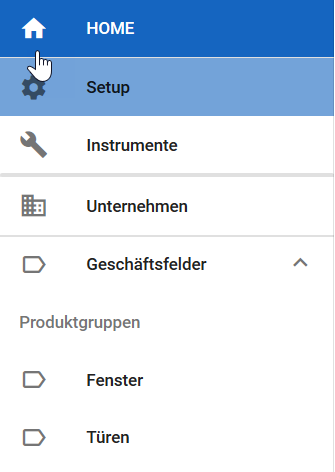
The levels are showns in the left navigation
- Home
- You can come back here anytime. You are here on the homepage and have access to the administrative part of the project.
- Set up
- In addition to the company date you place here the time horizon for the strategy plan and the structure of the business units
- Instruments
- At this level you select the tools and parameterize them according to the needs of your company
- Company On the company level, you will be guided through the process of the corporate strategy
- Business fields
- On the BU level, you develop the strategies for each business unit, starting with the analysis through design and planning towards the implementation of your strategy
Phases
The phases are shown on the horizontal navigation

Depending on the level, this navigation is different. When developing a business field strategy, this process leads from form the specifications over analysis and design to planning. Each phase is divided into individual steps - Here you can see the steps of the specifications
- Mission Statement
- eBMC
- Description of the business unit
- Financial goals
- Strategy goals
Thus, you always see where you are in the application - here, for example.
at the company level
in the phase analysis
in the step Portfolio
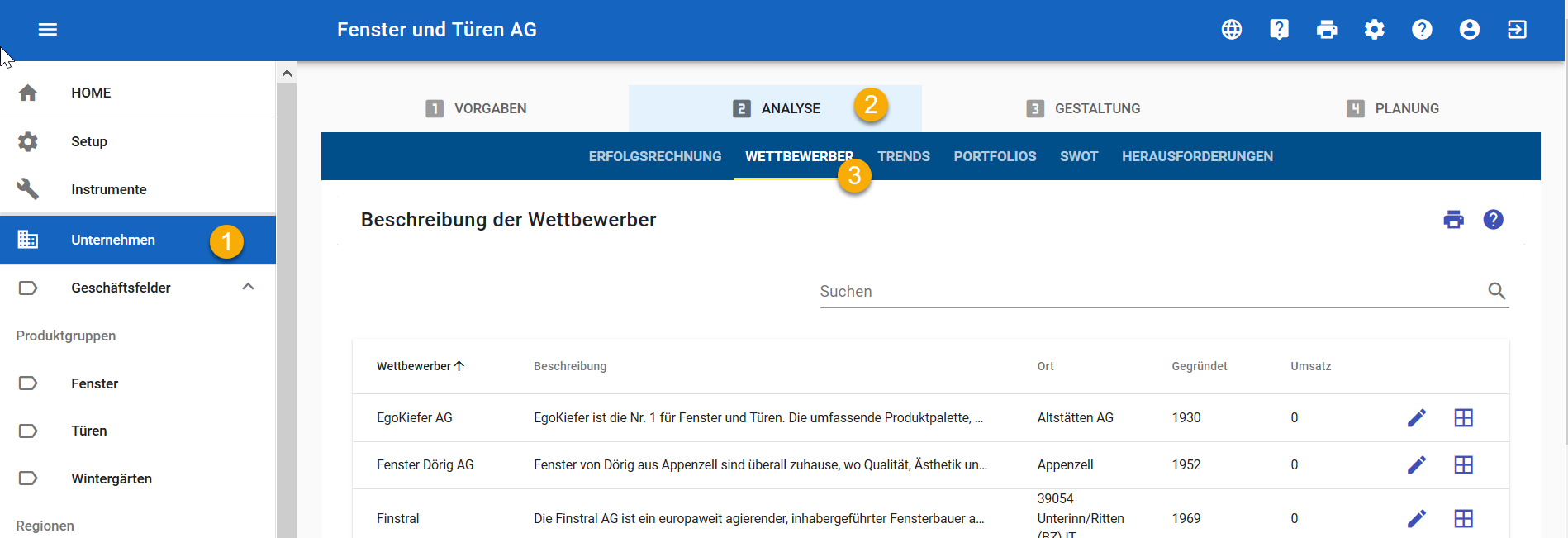
Handling
Dialogs
The handling of the date follows these principles
Click on a level on the left - you end up on the first phase and the first step
Now you can select the individual phases and get on the first step
You choose the step
All entries are controlled via dialog windows. Before the data is saved or deleted, you are asked to confirm it.
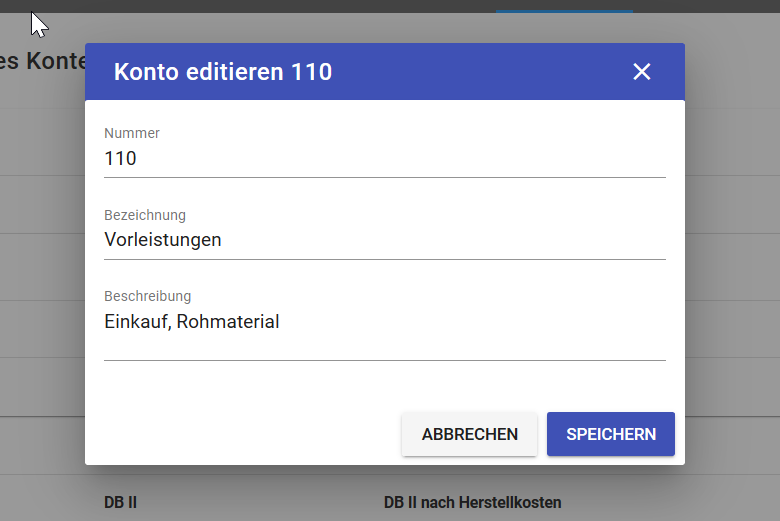
Icons
The icons have the following meaning:
| Icon | Action | What is being done |
|---|---|---|
| Edit | the data of this line or this site can be edited | |
| Add | add a element | |
| Delete | the data of this line or this site can be deleted | |
| Chart | the data is shown in a chart | |
| Multiline-Chart | a multiline-chart is being displayed | |
| print the site on a PDF or a printer | ||
| Download | download manuals for a certain step or a workshop | |
| Sample | display samples |
Themes
Competitors
The competitors are being handled on three levels
- at the configuration of the business structure
- at the company level
- at the business unit level
- Configuration: All competitors with whom your business is
dealing with are listed in the configuration.
The information requested here is minimal:
Name of the competitor, location, year of foundation, form of ownership,
number of employees, current turnover, internet address,
a short description and a comment:
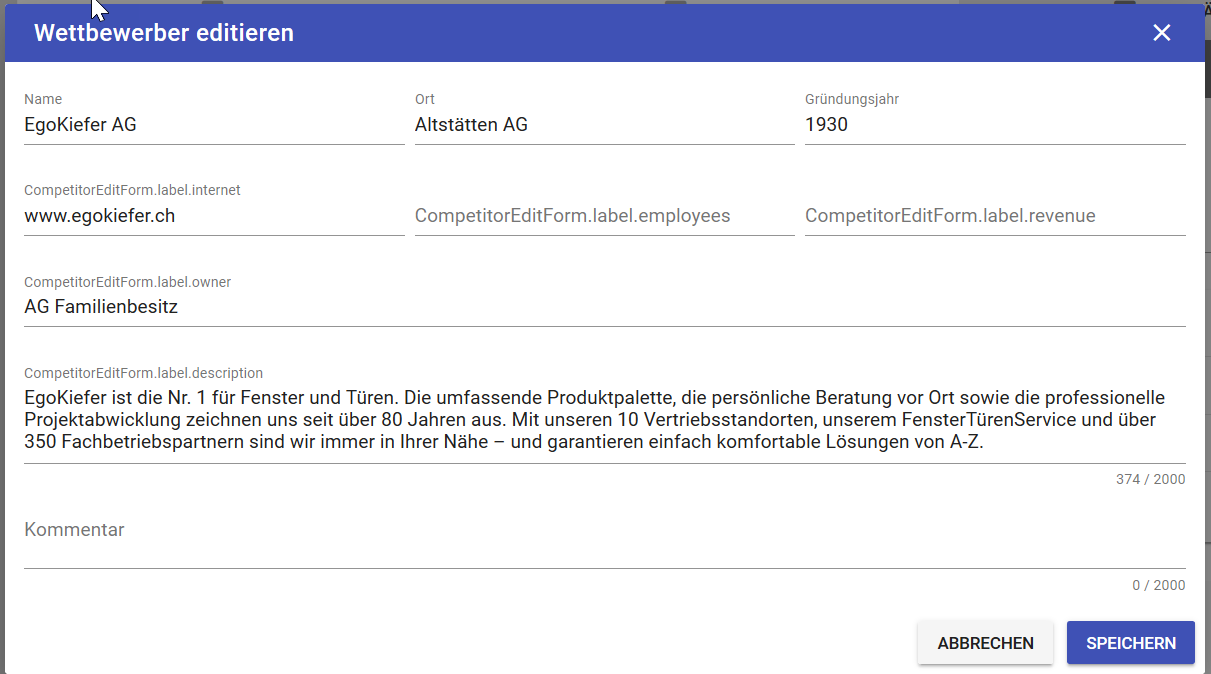
At the same level, the competitors are assigned to the business units. This in a matrix where the business units are specified in which one Competitor operates. Once a competitor is checked, this will generate the data records in the respective business area, so the business unit specific information can be provided.
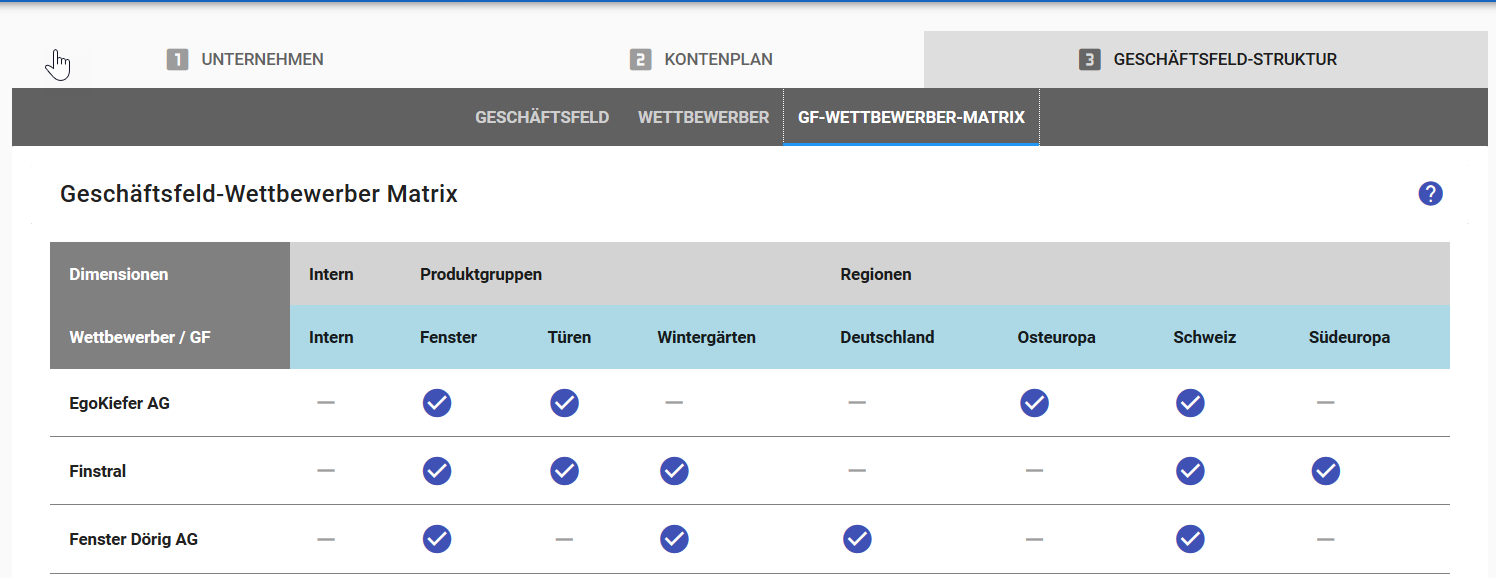
- Company level: At the copmany level, the competitor is described in detail, with all those relevant to the corporate strategy. In addition, a strength-weakness diagram is created.

- Business unit level: At the business field level, the associated competitors are considered from the perspective of this one business unit. This concerns both the quantitative and the qualitative data. It may well be that one or the other statement are being repeated. The strengths and weaknesses profile is also created for each business unit.
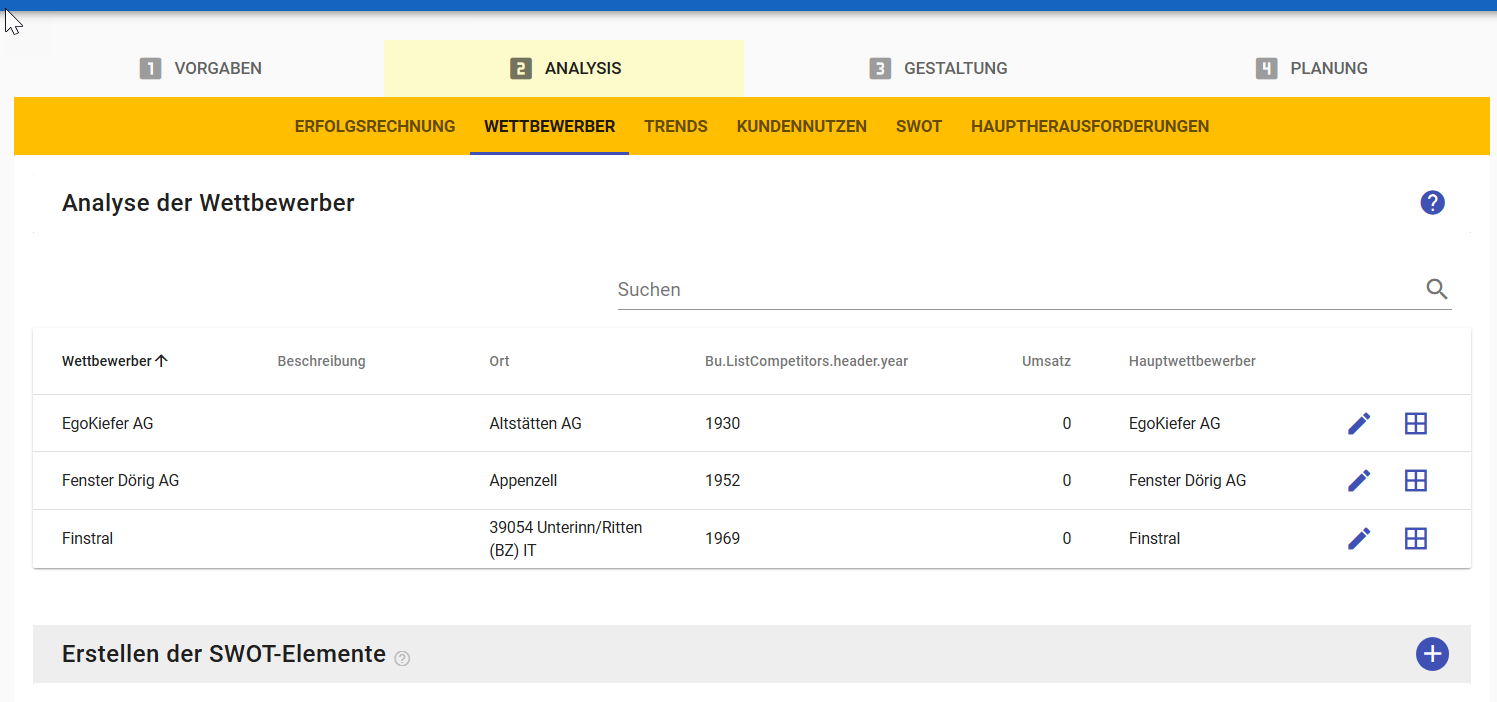
Tools
- Selection: Here we provide you with the most common tools for strategy development. It happens that most instruments have been created for the analysis phase. Some of these tools are set, others can be activated as needed. Instruments that are available for selection appear in the menus as soon as they are selected. If the selection is canceled, they no longer appear. Any data that has already been entered will not be deleted.
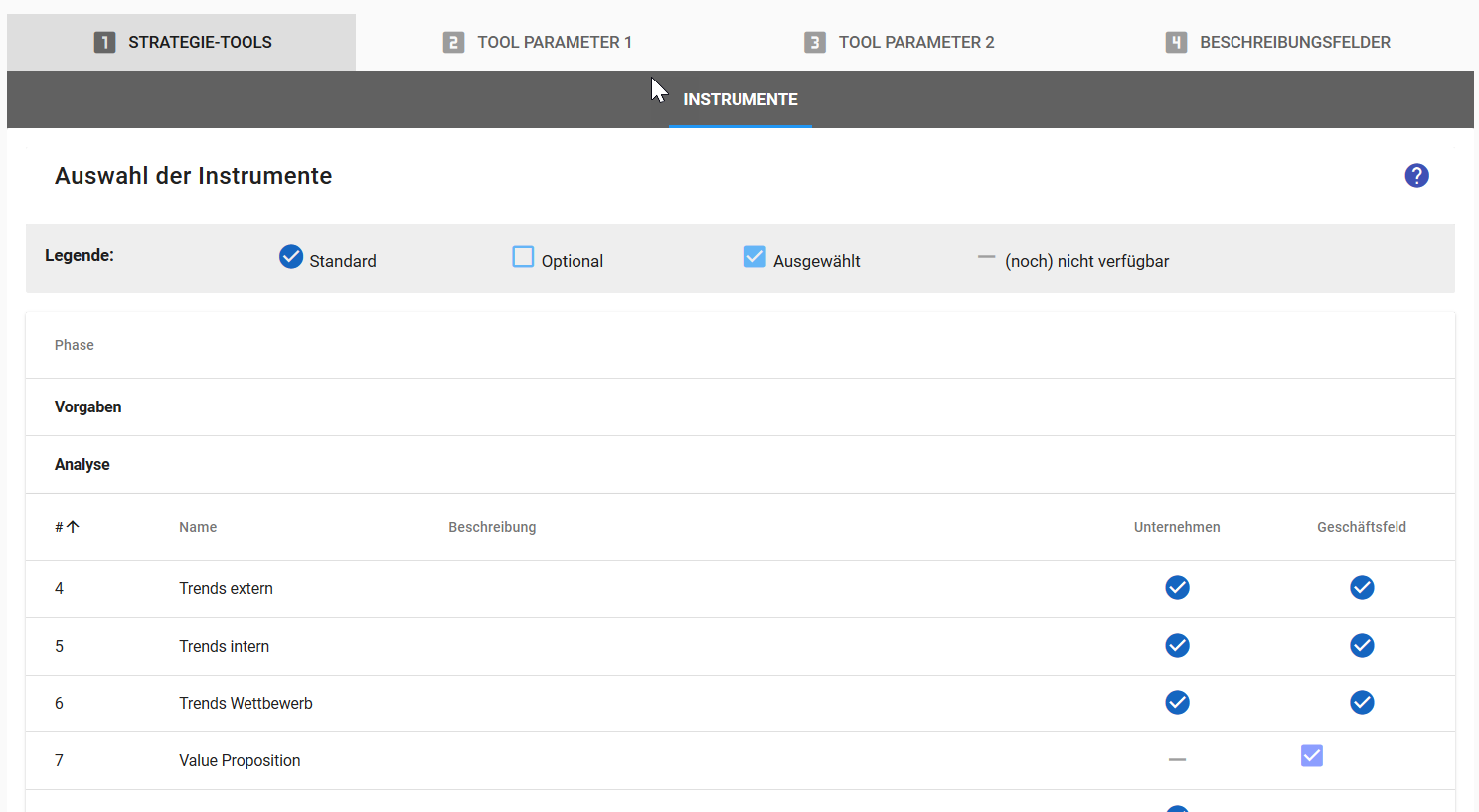
- Parameter: The instruments can be parameterized. A few parameters are fix; for example, the two dimensions of market position and market attractiveness for the business unit portfolio. We specify default parameters for all instruments that you can change, adjust, extend or delete as needed. Thus, e.g. for the market position the four parameters
- Absolute market share
- Relative market share
- Cost item
- Customer loyalty
are specified. Where necessary, values can be entered for the calculation. For example, let's set the minimum value for the cost item to 70, the maximum value to 130.
The exact meaning of these values can be found in the description of the parameters for the individual instruments.
Profit and Loss
1. Use: The income statement captures the figures of the past. According to the number of years set in the setup, the amounts can be entered here for each account. The result serves as an analytical tool from which SWOT elements are derived, which then flow into the SWOT.
2. Structure: The income statement can be entered per business unit (for each dimension), under Business Segments / GF / Defaults / Income Statement.
If the figures are not broken down into the business units, the program allows the data to be recorded at company level. This is done under Company / Specifications / Income statement
Numbers should only be entered at one level, either at the copmany level or at the business unit level.
3. Consolidation: The income statement is consolidated at the company level as follows: Sum of the numbers of all business units of the dimension selected as the primary dimension. The corresponding indication appears under the dimension. In addition, the numbers entered at the company level are added.
Thus, they can e.g. Enter the sales and gross margins at the business unit levels, all the lower contribution margin up to the EBIT at the company level.
Measures
1. Purpose: The measures specify the implementation of the strategy. These are usually not simple activities, but medium to large projects, which are involved in a more or less extensive project management.
We will list these measures with goals and deadlines, but do not provide a project management. There are standard programs that do this better. This alos separates the strategic level from operational implementation.
What we need at the strategic level is a controlling that shows who has done what and when. Who is involved in detail, is regulated on the operational level by a project management.
In this sense, we provide here a management tool: who completed what until when.
2. Derivation of measures: As a rule, the "strategic measures" are derived from the strategic directions. Here they appear as an immediate consequence of the described in the strategic direction. A strategic direction can thus be divided into several measures or projects. The downside here is that first of all the whole process, from the analysis to the design, to the selection of the strategic dierecionts in the roadmap has to be crossed, and that can sometimes take too long.
That's why we offer the opportunity here to formulate strategic measures out of the main challenges. This will skip the steps Options - Adjacencies and Strategic Directions
Each measure is organizationally assigned to a business area or function. At the moment, only the option "internal" is available as a function. This will be added later together with the instrument "Functional requirements".
3. Implementation: One is the formulation and assignment of measures, the other their follow-up and ongoing adaptation to the changed circumstances. For this purpose, a measures controlling is set up. This is part of the strategic controlling, which consists of three elements:
- Measures controlling
- Cornering control
- Early warning system For a detailed description of the strategic controlling please refer to www.www.com.
Printing and Report
The screen pages can each be printed individually. For this purpose, a PDF is created that you can save or print. You can enter a title for this print, which represents the main message of the page.

The dialog box can be used to specify whether this page is part of the strategy report. If the appropriate box clicked is, the page is included in the strategy report.
Attention: after clicking on Print, it will take a moment until the page is created and the PDF appears.
ISO 9001:2015
With the release of the new ISO9001 standards in 2015, the following strategic aspects of enterprise development have been incorporated, making them an integral part of quality control today:
These are in particular:
The strategic direction of the organization: The strategic orientation of an organization will in future also include the quality management system. Leadership is responsible for ensuring that quality objectives and policies are aligned with strategic direction. This requires that internal and external aspects be considered that have an impact on the organization's goals, strategy and outcomes.
The extension of the target groups: For ISO 9001: 2015, all parties and their needs that are relevant to the QM system must be identified in the future. These are not just the customers, but can also be employees, business partners, competitors or suppliers. The focus on customers will be expanded to include new target groups, in the center of quality management. The organization has to record the influence that the relevant groups have on the quality of products and offers.
The risk management: The requirement for systematic handling of risks and opportunities is also being included in ISO 9001: 2015. In the future, organizations must identify, analyze and evaluate risks and opportunities as well as plan, implement and monitor their effectiveness. How they do this is not specified by ISO 9001: 2015.
These three aspects are part of the strategic analysis for the corporate strategy. On the one hand, the statements and results in the form of a SWOT form the basis for the development of strategic options and business plans. On the other hand, the measures that can be derived from this can be embedded in the overall strategy of the company.
With Strategy.app, a standardized set of tools is now available that covers you step-by-step through the strategy process while at the same time covering all these aspects in accordance with the requirements of ISO 9001: 2015.
Home →
